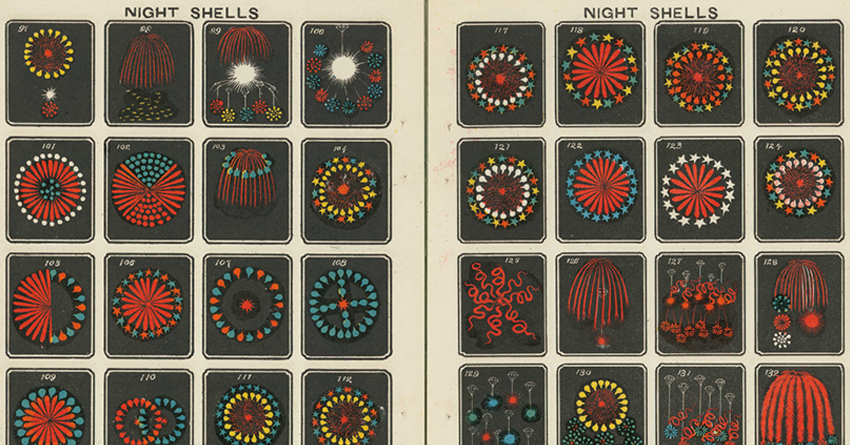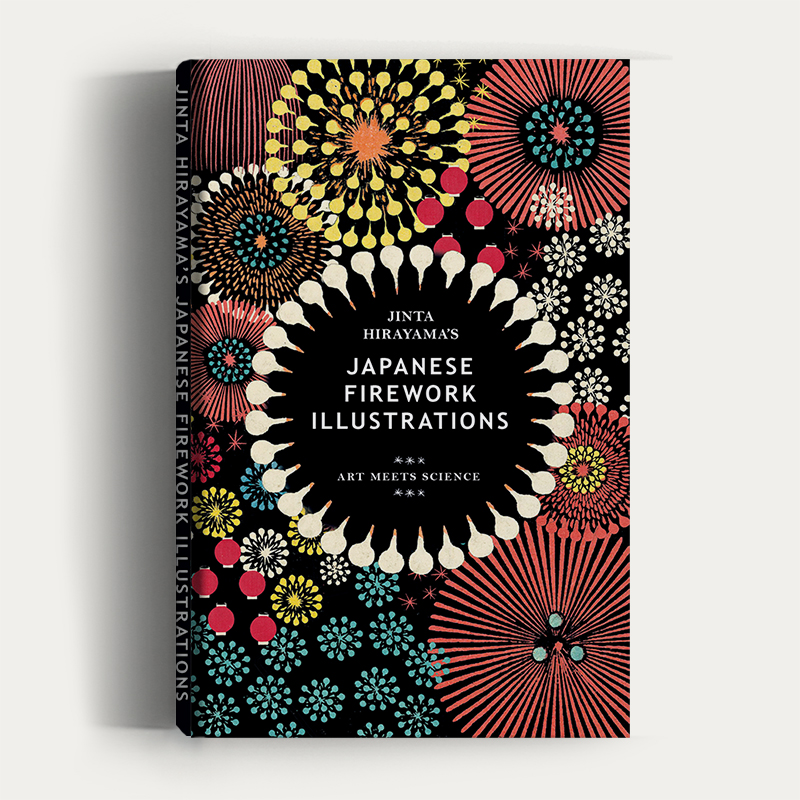The Art of Japanese Fireworks
First introduced in the 1600s, Japanese fireworks, known as hanabi, played a pinnacle role in global pyrotechnic innovation regarding shape, colour, and design. The development of hanabi (which translates directly to ‘fire flower’) started small, based on early versions of flares, but they were soon woven into the culture of public life, their roots set deep in the socio-political history of Japan, where the artisanal pyrotechnic craft became its own unique art form.
Fireworks hold cultural significance as physical and metaphorical symbols of ephemeral beauty within the Japanese culture, sitting at the unique intersection where the arts and science collide. Discover the history of the artisinal craft of hanabi, artfully preserved in nineteenth century Uikyo-e prints.
Captured in a collection of traditional Japanese woodblock illustrations, this edition reframes fireworks not simply as entertainment but as objects of craftsmanship, design, and cultural significance. Discover the historical art of fireworks in Japan, documented in the captivating work of one of the pioneers of modern fireworks.
The History of Fireworks in East Asia
Fireworks trace their origins to ancient China, around 200 BCE, when the Chinese first discovered that bamboo could explode when thrown into a fire. The hollow air pockets in bamboo would heat up, expand, and eventually burst, creating a loud bang. The sound was thought to ward off evil spirits and was used to celebrate major events.
In the 9th century, Chinese alchemists inadvertently created gunpowder by mixing saltpeter (potassium nitrate) with sulfur and charcoal. This combination, initially aimed at creating a potion for immortality, resulted in an explosive powder instead. When this gunpowder was placed inside bamboo tubes and lit, it produced an bright explosion similar to those we see in modern pyrotechnics.
The Art of japanese fireworks
First introduced to Japan in the early seventeenth century, fireworks (hanabi: translating to ‘fire flower’) became central to both global pyrotechnic innovation and Japanese cultural expression. Their development began small, based on early versions of flares, but they were soon woven into the culture of public life, with the artisanal pyrotechnic craft evolving as its own unique art form. While their roots are set in the socio-political history of Japan, they also hold cultural significance as physical and metaphorical symbols of ephemeral beauty. Their shapes, colours, and effects represent some of the most pioneering achievements in pyrotechnics, sitting at the unique intersection of artistry and technical mastery.
the Ryōgoku Kawabiraki Fireworks Festival
In 1733, the shogun Yoshimune (1684–1751) hosted a grand fireworks display to commemorate those lost during a period of disease and famine that swept through Edo. The annual event, the Ryōgoku Kawabiraki Fireworks Festival, was established—a celebration that still exists to this day. This official backing was a key moment in pyrotechnic advancement, utilising a surplus in materials to create fireworks of all sizes and colours for grand public display.
Fireworks soon became an integral part of Edo’s culture, and following several considerable fires within the city, they were relocated to the banks of the Sumida River. Displays became popular along the river during the summer months, often funded by the rich merchants who passed through the city. Pleasure boats and stalls became commonplace with the public who flocked to the area to marvel at the pyrotechnic crafts of the firework masters. In 1733, the shogun Yoshimune (1684–1751) hosted a grand fireworks display to commemorate those lost during a period of disease and famine that swept through Edo. The annual event, the Ryōgoku Kawabiraki Fireworks Festival, was established—a celebration that still exists to this day. This official backing was a key moment in pyrotechnic advancement, utilising a surplus in materials to create fireworks of all sizes and colours for grand public display.
Night Shells
In the early nineteenth century, the title of Hanabishi (firework artisan) formalised the craft, and rival firework companies spurred competition in designs. The trademark round explosions of modern fireworks, composed of Stars, were a signature design of this period. Traditionally, colours were produced by incorporating natural pigments and mineral salts into the gunpowder composition, with the design inspired by the shapes of traditional Japanese flowers, such as peonies (botan) and chrysanthemums (kiku): the sparkling, coloured arms of each burst representing the layered effects of their petals. This, coupled with the advent of potassium chlorate later in the century, allowed each Hanabishi to produce vibrant, multi-coloured effects, unlike any seen elsewhere in the world.
Hanabi and UKIYO-e
While material advancement aided the development of hanabi throughout the Tokugawa shogunate, the cultural growth of the period also played a role. Fireworks were a perfect curio for the newly born city of Edo, known as the Floating World, or Ukiyo, whose cultural identity centred on frivolity, decadence, and aesthetics.
The artists of the Floating World found in fireworks a natural subject. Their woodblock prints, Ukiyo-e, reflected the transient pleasure and hedonistic indulgence of Edo. These visual representations weren’t merely decorative; they documented public spectacle, technological evolution, and a social mood that extended beyond novelty to wider national identity.
Jinta Hirayama's Japanese Firework catalogues
In the late-nineteenth century, Jinta Hirayama (1840–1900) was the first Japanese citizen to obtain a U.S. patent for his designs. His fireworks company produced multiple catalogues showcasing their fireworks for sale overseas. The catalogues feature Ukiyo-e woodblock print illustrations that beautifully capture the shape and colour of each firework. Artfully capturing the fleeting effects of the hanabi at their point of explosion, the clear and simple designs showcase the skill of the Hanabishi as well as the craft of the Ukiyo-e woodprint style
.しばらくは闇のともしを花火哉
shibaraku wa yami no tomoshi wo hanabi kana
for a moment
our darkness is lit…
fireworks
—Kobayashi Issa (1763–1828)
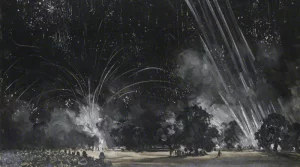
The Brilliant Art of Fireworks: A Fusion of Chemistry, History, and Light
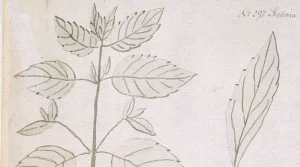
Jane Colden and the Flora of New York: The Art and Science of Women in Botany
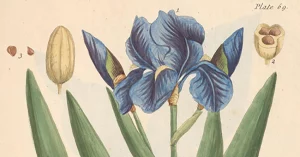
Elizabeth Blackwell’s Curious Herbal: The Art and Science of Women in Botany
Discover the Art Meets Science Collection
-
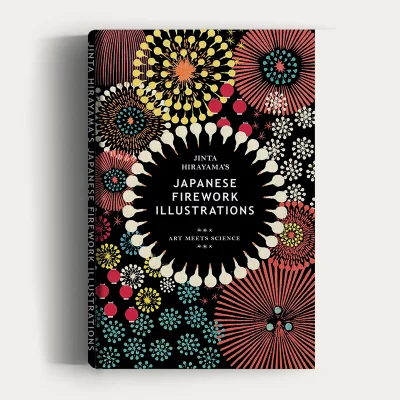 Art/Chemistry/Illustration/Japanese Woodblock/Pyrotechnics/ScienceSelect options This product has multiple variants. The options may be chosen on the product page
Art/Chemistry/Illustration/Japanese Woodblock/Pyrotechnics/ScienceSelect options This product has multiple variants. The options may be chosen on the product pageJinta Hirayama’s Japanese Firework Illustrations
£6.99 – £24.99Price range: £6.99 through £24.99 -
 Nature/Botany/Illustration/Mushrooms/MycologySelect options This product has multiple variants. The options may be chosen on the product page
Nature/Botany/Illustration/Mushrooms/MycologySelect options This product has multiple variants. The options may be chosen on the product pageAnna Maria Hussey’s Mushroom Illustrations
£7.99 – £29.99Price range: £7.99 through £29.99 -
 Art/Color TheorySelect options This product has multiple variants. The options may be chosen on the product page
Art/Color TheorySelect options This product has multiple variants. The options may be chosen on the product pageMunsell’s Colour System
£7.99 – £25.99Price range: £7.99 through £25.99 -
 Art/Astronomy/ScienceSelect options This product has multiple variants. The options may be chosen on the product page
Art/Astronomy/ScienceSelect options This product has multiple variants. The options may be chosen on the product pageUrania’s Star Charts
£7.99 – £29.99Price range: £7.99 through £29.99 -
 Art/Color TheorySelect options This product has multiple variants. The options may be chosen on the product page
Art/Color TheorySelect options This product has multiple variants. The options may be chosen on the product pageEmily Vanderpoel’s Color Problems
£7.99 – £34.99Price range: £7.99 through £34.99 -
 Animals/Butterflies & Moths/NatureSelect options This product has multiple variants. The options may be chosen on the product page
Animals/Butterflies & Moths/NatureSelect options This product has multiple variants. The options may be chosen on the product pageMaria Sibylla Merian’s Metamorphosis
£9.99 – £34.99Price range: £9.99 through £34.99 -
 Human Anatomy & Physiology/Life Sciences/ScienceSelect options This product has multiple variants. The options may be chosen on the product page
Human Anatomy & Physiology/Life Sciences/ScienceSelect options This product has multiple variants. The options may be chosen on the product pageHenry Gray’s Anatomy
£9.99 – £39.99Price range: £9.99 through £39.99 -
 Artists' Books/Individual Photographers/PhotographySelect options This product has multiple variants. The options may be chosen on the product page
Artists' Books/Individual Photographers/PhotographySelect options This product has multiple variants. The options may be chosen on the product pageAnna Atkins’ Cyanotypes of British and Foreign Ferns
£9.99 – £24.99Price range: £9.99 through £24.99 -
 Life Sciences/Marine Biology/ScienceSelect options This product has multiple variants. The options may be chosen on the product page
Life Sciences/Marine Biology/ScienceSelect options This product has multiple variants. The options may be chosen on the product pageErnst Haeckel’s Art Forms in Nature
£9.99 – £28.99Price range: £9.99 through £28.99 -
 Geometry/MathematicsSelect options This product has multiple variants. The options may be chosen on the product page
Geometry/MathematicsSelect options This product has multiple variants. The options may be chosen on the product pageOliver Byrne’s Elements of Euclid
£9.99 – £33.99Price range: £9.99 through £33.99 -
 Art/Color TheorySelect options This product has multiple variants. The options may be chosen on the product page
Art/Color TheorySelect options This product has multiple variants. The options may be chosen on the product pageWerner’s Nomenclature of Colours
£9.99 – £22.99Price range: £9.99 through £22.99

